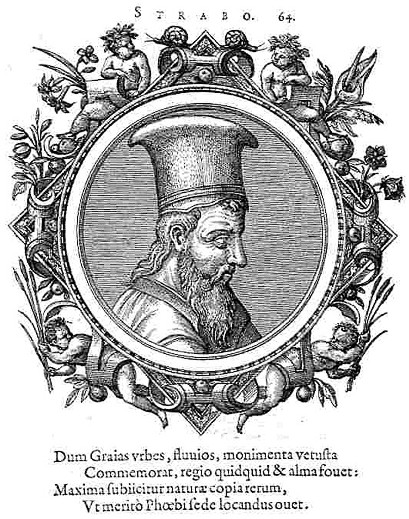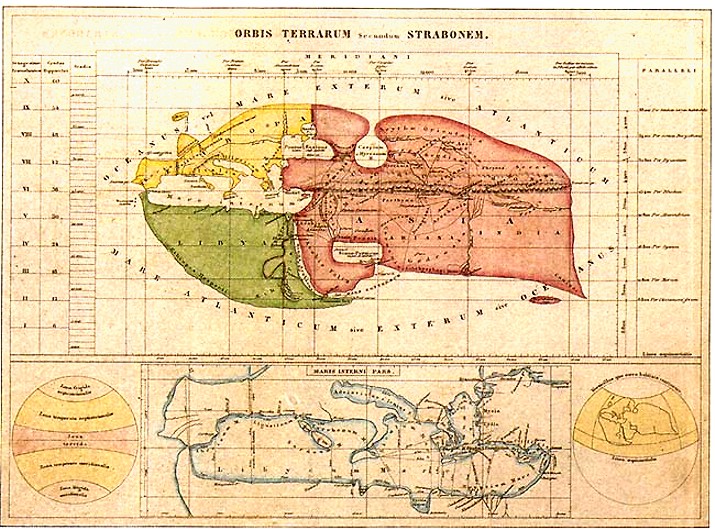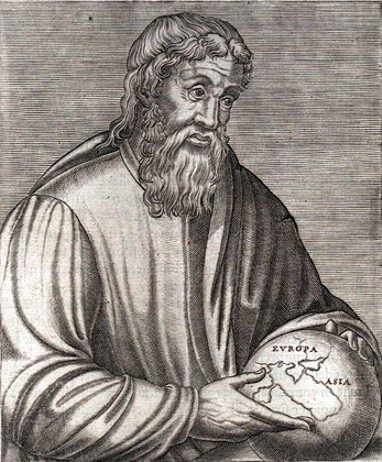Lessico
Strabone

Icones veterum aliquot ac recentium Medicorum
Philosophorumque
Ioannes Sambucus / Jßnos Zsßmboky![]()
Antverpiae 1574
In greco Strßb°n, in latino Strabo -onis. Storico e geografo greco (Amasia, Ponto, 64/63 aC - ca. 20 dC). Studi˛ a Nisa col grammatico Aristodemo e, forse nel 44, si trasferý a Roma, dove ebbe come maestri Senarco e Tirannione.
In filosofia pratic˛ prima l'aristotelismo, poi lo stoicismo; fu grande ammiratore di Roma e del suo impero. Sono andati perduti i suoi Schizzi storici, che comprendevano 47 libri e riguardavano gli ultimi secoli della Repubblica romana; ci rimane invece la Geografia in 17 libri: dopo una specie di introduzione sulla scienza geografica e sui suoi predecessori (libri 1-2), Strabone inizia, nell'ordine, la descrizione dell'Europa, dell'Asia e dell'Africa.
L'universo immaginato da Stabone Ŕ geocentrico e la Terra Ŕ circondata tutta dall'oceano. Le informazioni geografiche sono date in forma facilmente leggibile e interessante; scarsi i dati astronomici, mentre abbondano quelli storici ed etnografici e le considerazioni filosofiche; abbondano anche le digressioni, su diversi argomenti che apparivano notevoli allo scrittore. L'opera Ŕ assai importante per la massa di dati che ci trasmette anche al di lÓ della pura scienza geografica.
The Greek geographer Strabo in a 16th century engraving
Strabo (63/64 BC ľ ca. AD 24) was a Greek historian, geographer and philosopher. He is mostly famous for his 17-volume work Geographica, which presented a descriptive history of people and places from different regions of the world known to his era.
Strabo
was born in a wealthy family from Amaseia in Pontus (modern Amasya Turkey),
which had recently become part of the Roman Empire. He studied under various
geographers and philosophers; first in Nysa, later in Rome. He was
philosophically a Stoic and politically a proponent of Roman imperialism.
Later he made extensive travels to Egypt and Kush, among others. It is not
known when his Geography was written, though comments within the work itself
place the finished version within the reign of Emperor Tiberius![]() .
Some place its first drafts at around AD 7, others around 18. Mention is given
to the death in 23 of Juba, king of Maurousia. Strabo's History is nearly
completely lost. Although Strabo quotes it himself, and other classical
authors mention that it existed, the only surviving document is a fragment of
papyrus now in possession of the University of Milan (renumbered [Papyrus]
46).
.
Some place its first drafts at around AD 7, others around 18. Mention is given
to the death in 23 of Juba, king of Maurousia. Strabo's History is nearly
completely lost. Although Strabo quotes it himself, and other classical
authors mention that it existed, the only surviving document is a fragment of
papyrus now in possession of the University of Milan (renumbered [Papyrus]
46).
Several different dates have been proposed for Strabo's death, but most of them place it shortly after 23.
The Geography
The
Geography is an extensive work in Greek, spanning 17 volumes, and can be
regarded as an encyclopedia of the geographical knowledge of Strabo's time.
Except for parts of Book 7, it has come down to us complete. Yet, while it
does cover the entire world known to the Greeks and Romans of his time, it
suffers from several major flaws: a constant and very intrusive defense of the
poet Homer![]() as a geographical source, leading Strabo to dismiss more recent writers, such
as Herodotus
as a geographical source, leading Strabo to dismiss more recent writers, such
as Herodotus![]() ,
who claim to have witnessed the events they reported; a preoccupation with
minute, often captiously argumentative, criticism of these other writers; a
peculiarly Greek aprioristic attitude to facts, seeking to derive them from
the pure exercise of reason. In sum, one would prefer more geography and less
argumentation. These byways, however, do provide modern scholars with valuable
historical information on the methods of ancient geography and on many older
geographers whose works are lost.
,
who claim to have witnessed the events they reported; a preoccupation with
minute, often captiously argumentative, criticism of these other writers; a
peculiarly Greek aprioristic attitude to facts, seeking to derive them from
the pure exercise of reason. In sum, one would prefer more geography and less
argumentation. These byways, however, do provide modern scholars with valuable
historical information on the methods of ancient geography and on many older
geographers whose works are lost.
Some thirty manuscripts of the Geography, or parts of it, have survived. Almost all of these are medieval copies, though there are fragments from papyri which were probably copied some time between 100 and 300. Scholars have struggled for a century and a half to produce an accurate edition close to what Strabo wrote. One definitive edition has been in publication since 2002, appearing at the rate of about a volume a year.

